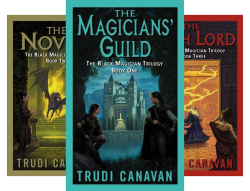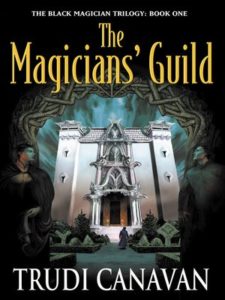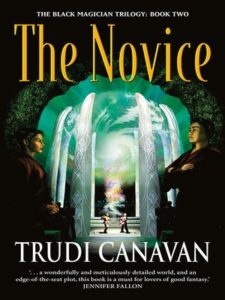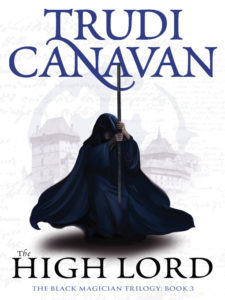Review: The Black Magician Trilogy
Review by Christopher G. Nuttall
Trudi Canavan
One of the downsides of Harry Potter’s success was that any other wizarding school books ran the risk of being branded copycats or rip-offs. It was quite hard for a number of post-Goblet of Fire books to establish their own identity, particularly as a number of boarding school fundamentals were hardly unique to Potter. The Black Magician Trilogy was one of the handful that managed to secure themselves an independent position in YA fiction. Even now, after a prequel and a successor series, it is still quite readable.
The trilogy is set in a fantasy world, where a relative handful of the population have magic (the magic system is very different to Harry Potter). All magicians are required to join the Magician’s Guild, which unlocks their powers; unsurprisingly, this ensures that magic is largely concentrated in the hands of the aristocracy. Common-born people often have magic potential, but they are largely unable to use it as the guild is unwilling to unlock their powers, let alone allow them to join. Among other things, the guild helps purge the city of urban poor every year …
… Until something goes spectacularly wrong.
During one purge, a commoner girl called Sonea discovers that she is a ‘natural’ magician – one so powerful that her powers spontaneously unlock. Unfortunately for her, the guild discovered her existence in the same moment she discovered her powers. Worse, Sonea’s powers will eventually overload and cause an explosion, unless she is taught how to control them. She must be found.
The Magician’s Guild centres around her flight from the guild, her eventual capture and her choice to – eventually – join the guild. The Novice centres around her training and struggles to overcome classism from some of the other novices; The High Lord is centred around the titular High Lord (Akkarin) and his covert battle to save his country from a deadly outside threat, a battle that eventually spills into the open and leads to the first invasion of the city by a long-forgotten threat …
The series is definitely written for older readers than Harry Potter, but it possesses a certain charm. Sonea herself is a likeable character, someone who has a great deal to learn (and faces a great deal of discrimination) and yet doesn’t give up. The author created a genuine strong female character, one whose progress can be followed as she grows from a slum girl into a confident magician. She is no Mary Sue. She makes mistakes, but they are understandable and plausible mistakes. People who made fun of Rey’s impossibly-fast development in The Force Awakens and The Last Jedi might want to read this series as a curative.
The other characters are fairly well developed, even some of the darker ones. Indeed, one of the most impressive parts of the series is how they change and develop. We see Akkarin through Sonea’s eyes: first, as a towering and terrifying figure; later, as a hero and Sonea’s eventual love interest. The author deserves credit for revealing his character – and his true nature – in a manner that feels natural, rather than shoehorned into the plot. She also illustrates the problems Akkarin faced in concealing both his true power and the threat facing his kingdom, neatly avoiding much of the idiot ball.
Thankfully, the book does not focus that much on romance. Sonea and Akkarin’s brief tryst is presented more as a reaction to stress than True Love, although the author doesn’t quite avoid the more classic tall, dark and brooding tropes. (The book is very clean; it’s clear they had sex, but the text doesn’t go into details.) Sonea also seems to attract a lot of interest from other men, which may or may not be a good thing.
The books do manage to be reasonably stand-alone, although the problems caused by ‘black magic’ form an underlying thread through The Magician’s Guild and The High Lord. The author manages to introduce her universe without bogging us down too much, although there is a plotline in The Novice that feels unnecessary to the overall plot. The series also avoids gender politics to a considerable extent; the guild generally sees male and female magicians as equals, although not every country agrees on this. That said, one of the lesser characters does have a homosexual romance that feels a little shoehorned in (not least because it’s part of the side-plot in The Novice.)
There are also issues with the background that irritated my inner critic. The battle is over the use of black magic (a form of magic used to steal power from other magicians). At some point in the past, the guild abandoned it, deliberately destroying (almost) all knowledge of its existence. And yet, with enemies who also used black magic, it seems unwise to deliberately hide information the guild might desperately need sooner or later. This leads to another issue: if one needs to be taught black magic, then who taught Akkarin? His power is, by their lights, proof that there is an outside threat. The guild firmly grasped the idiot ball when it sent Akkarin and Sonea away from the city, a decision that nearly led to utter disaster.
(And simply logic suggests that someone must have discovered black magic in the first place.)
Overall, though, the author wrote a very good book. The background is quite evocative, with what feels like a working (and workable) society. The hints of older magics and greater secrets are not explored (in this series, at least) but they add hints of depth to the universe. Familiar tropes are woven into newer and better patterns. Sometimes, it’s easy to guess where things will go; sometimes, you get surprised. And while some of the background characters fit familiar patterns, others do not; Akkarin, in particular, surprises the reader.
It’s not as detailed as Harry Potter. And it’s not as popular. But it is well worth a read.





Leave a comment